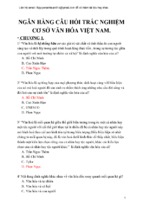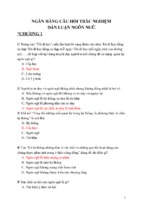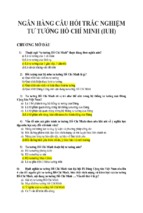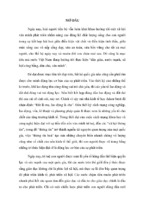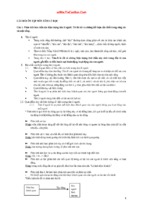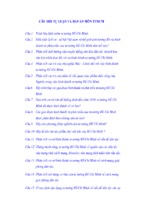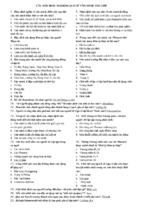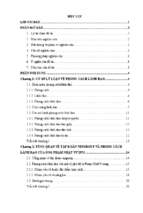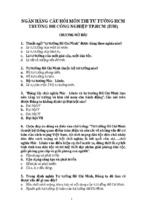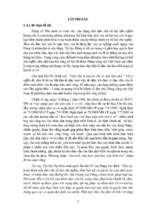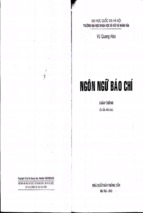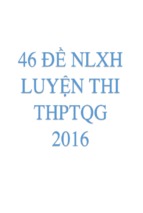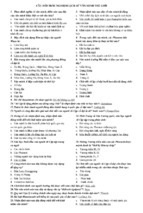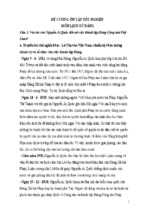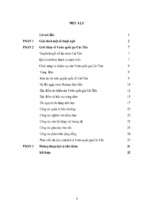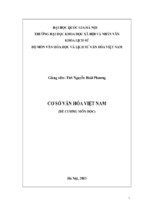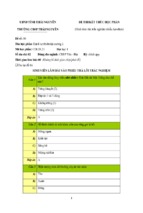UNIVERSITY OF ECONOMICS
INSTITUTE OF SOCIAL STUDIES
HO CHI MINH CITY
THE HAGUE
VIETNAM
THE NETHERLANDS
VIETNAM - NETHERLANDS
PROGRAMME FOR M.A IN DEVELOPMENT ECONOMICS
HEALTH INSURANCE AND PUBLIC
HEALTH CARE UTILIZATION IN
VIETNAM
BY
TRAN THE HUNG
MASTER OF ARTS IN DEVELOPMENT ECONOMICS
HO CHI MINH CITY, DECEMBER 2014
UNIVERSITY OF ECONOMICS
INSTITUTE OF SOCIAL STUDIES
HO CHI MINH CITY
THE HAGUE
VIETNAM
THE NETHERLANDS
VIETNAM - NETHERLANDS
PROGRAMME FOR M.A IN DEVELOPMENT ECONOMICS
HEALTH INSURANCE AND PUBLIC
HEALTH CARE UTILIZATION IN
VIETNAM
A thesis submitted in partial fulfilment of the requirements for the degree of
MASTER OF ARTS IN DEVELOPMENT ECONOMICS
By
TRAN THE HUNG
Academic Supervisor:
Dr. TRUONG DANG THUY
HO CHI MINH CITY, DECEMBER 2014
ABSTRACT
Vietnam is in the process of improving health system. To achieve this goal, the
Vietnam Government attempts to expend the coverage of public health insurance
which is an effective tool in low and middle income countries to finance health care
provision (WHO, 2000). Although the insurance coverage increases significantly over
the last ten years, the private expenditure on health is still high. It only reduces 6%,
particularly from 69.1% of total expenditure on health in 2000 to 62.9% in 2010
(WHO, 2013). This comes up with a question that whether health insurance improves
access to care? To answer this question, this study will assess the impact of health
insurance on health care utilization, particularly public health services through two
purposes: medical examination and treatment. A binary probit model is used to
estimate the impact of health insurance on public health care utilization. Then we
investigate determinants of insurance enrollment to increase the number of insurance
participators if insurance affects positively significant on health care use. Data are
obtained from Vietnam Household Living Standard Surveys (VHLSS) in 2010. The
empirical results indicate that insurance has a positively significant effect on public
health care utilization. In other words, we can conclude that health insurance actually
improve access to care. Moreover, the results of insurance participation show that
insurance enrollment is affected strongly by income and interaction terms of frequency
of illness. It is also remarked that demand for insurance is different between five
income quintiles. Finally, household’s characteristics including household’s size,
income and illness ratio affect significantly to insurance enrollment.
ACKNOWLEDGEMENT
This thesis is not only the result of my own effort, it also consists direct and
indirect supports of other individuals and organizations. I would like to express my
deep gratitude to them.
My academic supervisor, Dr. Truong Dang Thuy, is the person that I would like
to thank firstly. Without his comments and supports, I would not finish my thesis in
time and as good as this.
Furthermore, I would also like to acknowledge the Scientific Committee, the
lecturers and staffs of Vietnam-Netherlands Programme for the knowledge and
guidance during the period of studying and writing thesis.
Last but not least, I am grateful to my family for create favorable conditions to
help me learn better. Finally, I would like to thank my friends, especially “HLNTTV
Group” for their supports in the whole time of studying.
HCMC, December 2014
Trần Thế Hùng
TABLE OF CONTENTS
LIST OF FIGURES .......................................................................................................
LIST OF TABLES .........................................................................................................
CHAPTER 1: INTRODUCTION ....................................................................................
1.1
Problem statement ..............................................
1.2
Research objectives ............................................
1.3
Research question ...............................................
1.4
Research scope and data .....................................
1.5
The structure of this study ..................................
CHAPTER 2: LITERATURE REVIEW .........................................................................
2.1
Relationship between health utilization and insu
2.1.1 Health care usage theory .............................................................................
2.1.2 Theory of relationship between health insurance and health utilization ......
..............................
2.3
Empirical reviews of relationship between healt
utilization: ...................................................................................................................
2.4
Theory of insurance participation: .....................
2.5
Empirical reviews of insurance participation: ...
CHAPTER 3: RESEARCH METHODOLOGY ...........................................................
3.1.
An overview of Vietnam health system and hea
3.1.1.
Provider network..
3.1.2.
Access and utiliza
..............................
3.2.
Overview of health insurance ............................
3.3.
Methodology and data .......................................
3.3.1.
Methodology .......
3.3.2.
3.4.
Data ......
Measurement of variables and expected sign ....
CHAPTER 4: RESULTS ...............................................................................................
4.1.
Descriptive statistic.............................................
4.2.
Empirical results ................................................
4.2.1.
Impact o
4.2.1.1.
Medical
4.2.1.2.
Treatmen
4.2.2.
Determin
CHAPTER 5: CONCLUSIONS AND POLICY IMPLICATIONS ..............................
5.1
Conclusion remarks and policy implication ......
5.2
Limitation and further research .........................
REFERENCES ..............................................................................................................
APPENDIX
..............
LIST OF FIGURES
Figure 2. 1: Initial behavioral model of health services utilization.................................................8
Figure 2. 2: Modeling the effect of insurance programme on the use of health services . 21
Figure 3. 1: Proportion of seeking care in 2010....................................................................................33
Figure 3. 2: Timeline and roadmap of universal health insurance coverage...........................34
Figure 3. 3: Trend in health insurance coverage from 1993-2010...............................................36
LIST OF TABLES
Table 3. 1: Measurement of variables......................................................................................................40
Table 4. 1: Descriptive statistics of using public health care services by purpose................45
Table 4. 2: Descriptive statistics of insurance participation............................................................45
Table 4. 3: Descriptive statistics of continuous independent variables......................................46
Table 4. 4: Public health care use and insurance enrollment by gender....................................47
Table 4. 5: Public health care use and insurance enrollment by employment status...........47
Table 4. 6: Public health care use and insurance enrollment by area (rural)...........................48
Table 4. 7: Public health care use and insurance enrollment by minor ethnic people.........49
Table 4. 8: Results of impact of health insurance on medical examination.............................50
Table 4. 9: Results of impact of health insurance on medical treatment...................................52
Table 4. 10: Results of insurance participation (household level)................................................54
Table 4. 11: Results of insurance participation (individual level)................................................58
Table 4. 12: Results of insurance participation by different income quintile..........................61
iii
Tran The Hung
Master’s Thesis
VNP19-2014
CHAPTER 1: INTRODUCTION
1.1
Problem statement
After “Doi Moi” program in 1986, Vietnam has experienced rapid and continuous
economic growth with GDP per capita increases from 140 USD in 1992 to 1,168 USD
in 2010. Moreover, Vietnam’s poverty headcount drops from 60% to 20.7% in the past
twenty years (Work Bank, 2013). When people become more affluent, they will have
higher demand for care (McPake et al. 2002; Folland et al. 2004). Therefore, the rate of
healthcare usage increases significantly from 2002 to in 2010. Typically, percentage of
people having health treatment in 2002 is 18.9%, and then they rise to 40.9% of total
population in 2010.
Over the period of 2002-2010, healthcare utilization in Vietnam increases
dramatically. It suggests that people pay more attention to their health. As for 2010, the
percentage of people having health treatment is about 40.9%. Of which, the rates of
inpatient and outpatient are 8.1% and 37.1% respectively. There are two main kinds of
health care services that people use in Vietnam, including public and private health
care services. The percentage of people using public health care services is nearly
seventy percent; particularly, the ratio of inpatient hospitalized in public health services
is around 90.1% of total inpatient and 57.2% is the percentage of outpatient using
public health care services in 2010.
In the last ten years, Vietnam households still have to concern with a burden of
health care expenditure. The amount of money that people have to spend in health care
is much more than Government spending; private expenditure on health accounts for
around 62.9% of total expenditure on health while general Government expenditure on
health is around 37.1 in 2010 compared to Thailand with 25% of private expenditure
1
Tran The Hung
Master’s Thesis
VNP19-2014
and 75% of Government expenditure on health (World Health Organization 2013). The
major element that makes the large proportion of private expenditure is households’
out-of-pocket payment. Out-of-pocket expenditure is about 93% of private expenditure
on health in Vietnam 2010 (WHO, 2013). An increase in out-of-pocket payment on
health may lead households to sell their assets to be able to pay the treatment fees.
Most of households, especially poor households, have to pay such a substantial share of
their income for health service. As the result, they are pushed into poverty (World
Health Organization, 2004).
Health risk is probably the greatest threat to people’ lives because it impacts on
their direct expenditure and it also reduces their health affecting to labor supply and
productivity leading to income poverty (Asfaw, 2003). This author suggests that health
insurance is an effective tool to deal with health risk for the poor. In addition, health
insurance is as a part of income protection because it reduces financial burden of
treatment at low income levels (Jutting, 2003). Health insurance is also a tool in order
to create an equitable access to health services throughout the population at lowincome countries (WHO, 2000). Ensor (1995) discusses that voluntary health insurance
plays an important role in reforming overall health care system by making health
service provision more efficient.
Recognizing the important role of health insurance, many authors study the
relationship between health insurance and financial risk protection or health,
especially, impact of health insurance on health utilization. Saksena et al (2010) state
that health insurance has statistically significant positive impact on health care
utilization of health services when people are needed. For the poor, health insurance is
an effective tool which increases health care usage when they are sick (Jutting, 2003).
Health insurance does not only rise health care utilization, but it also increases the
2
Tran The Hung
Master’s Thesis
VNP19-2014
usage of physician services and preventive services and so it improves health (Freeman
et al, 2008).
Health utilization is affected by many determinants including demographic
factors; social structures, characteristics of family and community (Anderson, 1995).
The author argues that demographic variables such as age, gender, education have low
mutability, so they cannot be altered to change utilization; and cultural backgrounds
(ie, ethnicity, region) are not changeable to promote health care usage (Anderson &
Newman, 2005) while personal/family and community’s characteristics which include
an important factor: health insurance are quite mutable and strongly associated with
health utilization. For example, the impact of health insurance on health care use has
been demonstrated dramatically by The Rand Health Insurance Study such as the
studies of Manning et al (1987) and Jutting (2003). As a result, we can conclude that
increasing insurance participation is a good choice to accelerate health utilization; and
it is necessary for policy makers to adopt how the impact of insurance on health care
utilization is and then assess what are determinants of insurance participation so as to
create favorable conditions for people to join health insurance scheme, specially, for
the poor who do not have enough resources to use health services.
In this situation, the study will examine the effect of health insurance to health
care utilization at public health care services with different purposes including health
test and treatment. In other word, we will hypothesize whether health insurance
improves access to health care since many studies use health care utilization as a proxy
for access such as Fox (1972); Aday & Anderson (1974; 1995). After measuring the
impact of health insurance on health care usage, if the effect is positively significant
meaning that health insurance actually improves access to health care, we then
investigate determinants affecting to insurance enrollment. Then, the results are used to
recommend policy implications to improve insurance participation including:
3
Tran The Hung
Master’s Thesis
VNP19-2014
administrating stringently the insurance participation of employees and financial
intervention such as subsidies for different income quintiles, especially for low income
households with high illness ratio.
1.2
Research objectives
This study aims to identify relationship between insurance and public health
utilization of people in Vietnam. After that, determinants affecting health insurance
enrolment are measured in order to improve insurance enrollment. As such, there are
two main objectives in this study:
-
Impact of health insurance on health care utilization at public health services
using data from Vietnam Household Living Standard Survey in 2010.
-
Investigating determinants which impact to join the insurance scheme of
people. Then, policy implications are recommended to increase the number of
insurance participators.
1.3
Research question
This research aims to handle the question: Does health insurance actually improve
access to care at public services? If yes, how to improve insurance participation?
1.4
Research scope and data
The study examines the impact of insurance on health care usage of individuals
and determinants affecting insurance participation of households and individuals using
cross section data of Vietnam Household Living Standard Surveys (VHLSS) in 2010.
1.5
The structure of this study
There are five chapters in this study which are organized as follow:
4
Tran The Hung
Master’s Thesis
VNP19-2014
Chapter 2: literature review includes theory as well as empirical literature about the
relationship between insurance and utilization, also the determinants of insurance.
Chapter 3: research methodology which presents regression technique used and data
collection.
Chapter 4: empirical results. The statistic description is presented first, and then
explaining the empirical results. The coefficients of all factors will be interpreted and
discussed.
Chapter 5: summarizes the main results and some policy implications.
5
Tran The Hung
Master’s Thesis
VNP19-2014
CHAPTER 2: LITERATURE REVIEW
2.1
Relationship between health utilization and insurance
2.1.1
Health care usage theory
The behavior of health utilization has traditionally explained in five different
approaches including the sociocultural approach, the socio-demographic approach, the
social-psychological approach, the organizational approach, and the social systems
approach (Anderson, 1973).
For the sociocultural approach, health care usage is a part of a cultural complex
and, as such, related to other social institutions in a society or subculture. One example
of Shuval (1970) shows that the utilization of health services depends on the basic
latent functions of catharsis, cooperation with social system through contacts with
social institution, status achievement through such contacts, and the resolution of
conflicts between magic and science. Zborowski (1952) founds that responses to pain
among ethnic groups are different when he attempted individual utilization behavior. It
means that cultural condition affects to personal recognition of symptoms and the
responses to them.
For the socio-demographic approach, variations of utilization behavior can be
related to age, sex, education, occupation, ethnicity, socioeconomic status, and income.
As the theory of Moore (1969), the utilization of health care can be view as a type of
individual behavior which is a function of individual characteristics, characteristics of
environment where they live and maybe the interaction of these individual and societal
forces. The author emphasized the individual characteristics and less paid attention to
the societal impacts. This means that health utilization affected mostly by characteristic
of individual themselves such as age, education, gender, health status and income, and
6
Tran The Hung
Master’s Thesis
VNP19-2014
so on. Moreover, utilization among various groups within a population is also different
even when cost barriers are eliminated (Nolan et al, 1969).
For the Social-Psychological Approach, Stoeckle et al (1963) review much of the
analytic literature on the seeking of medical care and outline three major factors in the
patient’s decision of seeking care including individuals’ knowledge and attitudes
concerning symptoms; attitudes and expectations regarding to health services; and
individuals’ definition of illness. Similarly, in studying illness behavior, Mechanic
(1978) identified the theory of health seeking and found out various circumstances
affecting to the decision of seeking care. The first one is the salience of deviant signs
and symptoms. Individuals’ perception and tolerance of symptoms is the second and
third. Forth, disruption caused by illness affects to individual’s life. Fifth is the
frequency of illness and its persistence. And the final circumstance is the individual’s
knowledge and cultural assumptions of the illness.
For the organizational approach, the structure of health care system is examined
to account for differences of health care behavior. Regarding to Anderson’s study of
comparing health services in the United State, Sweden and England (1972), the
differences in the supply of physicians and hospitals’ beds leads to the changes of
variation in the use of hospital. Typically, if the supply of physicians and hospitals’
beds is deficient markedly, the use of health care services will be diminished.
Moreover, when the admissions increase, the average length of stays will drop. The
author also pointed out that each country has evolved a pattern of financing and
organization that is consistent with the unique characteristics of its social and political
systems. Hence, intervention strategies are necessary.
For the social systems approach, it has emerged as a way of understanding health
utilization. On the basis of social systems, in 1960’s, Anderson developed the initial
7
Tran The Hung
Master’s Thesis
VNP19-2014
behavior model looking at three categories of determinants such as predisposing
characteristics, enabling resources including factors which enable or impede use, and
people’s need for care that affects to people’s use of health services (Anderson, 1995).
Figure 2.1: Initial behavioral model of health services utilization
Predisposing
characteristi
cs
Demographic
Social
structure
Source: Anderson (1995)
In 1972, Anderson expended and refined the initial behavioral model in order to
predict the effect of changes in social structure of population and of supply of health
services including the supply of hospital beds, aggregate level of education,
employment, income and socio-demographic characteristics such as age, ethnicity and
ecological features on health utilization.
In addition, the updated utilization model can be characterized by purpose, type
and unit of analysis. In the case of purpose, health care utilization is as primary care
with stopping illness before it begins or secondary care with referring to the process of
treatment or tertiary care with providing stabilization for long-term irreversible
illnesses such as heart disease or diabetes. For type characteristic, health care
utilization is as a choice of health services such as Hospital, Physician, Drugs and
Medications, Dentist, Nursing Home, and Other. A final character describing the
utilization is the unit of analysis which includes the contact with a physician during the
8
Tran The Hung
Master’s Thesis
VNP19-2014
period of time or the using volume of services. Although health care utilization has
different characteristics, determinants affecting to use of health services are based on
characteristics of population and health services (Anderson, 1995; Andersen and
Newman, 2005).
In general, the extent of health care is to improve health which should be
primitive in the description of consumers’ preferences. Health care services would then
be demanded only as an input into the production of health, and the level of demand for
services would be determined by the extent to which they satisfied the individual’s
underlying preference for health. Individuals use their available resources to achieve
health, so their preferences for health are represented within a standard utilitymaximizing framework. All of alternative uses that individuals must have for their
resources to admit a choice are bundled into a generic good denoted c. The utility
function of health care use is:
= ( , ℎ)
Where h is level of health that individuals enjoy rather than quantity of health care
services consumed.
The demand for medical care is not constrained to a choice of how much, but also
of what kind meaning that individual can decide how often to visit, as well as choose
visiting various providers such as hospital, clinic, healer. After having made these
choices, consumers may also face the choice of what kinds of treatments they wish to
adopt including the use of drugs and other remedies. While many of these input
decisions will be based on recommendations made by the provider, such
recommendations may be altered with variations in prices and incomes. For an
individual with income m, the price vector defines a consumption vector as
9
Tran The Hung
Master’s Thesis
(
0, 1,…,
) = ( − 0,
− 1,…,
−
)
VNP19-2014
The function of health care utility can be rewritten as
= (ℎ, , )
Where m presents income and p is the price of medical services.
The existence of such discrete choices requires more elaborate econometric
techniques to estimate the demand curves. The discrete choice can be modeled in an
integrated fashion using a multilevel approach.
1 1
Where:
̂ = ̂( ) is the estimated use of medical care by individual i who consumes
̂( ) = ̂[ ̂ ̂ + ̂ ̂
2 2
+ ⋯+ ̂ ̂]
service j.
xi is a vector of regressors used to explain medical care use such as price, income and
demographic variables.
Category j = {1…n} assumed as a various types of medical care services including
clinics, public hospitals, traditional healers, and so forth.
And
̂ = ̂( ) is the estimated probability that individual i will consume some
quantity of medical care; ̂ = ̂ ( ) is the estimated conditional probability that
individual i will use medical service j. Formally, probability can be estimated as ̂ = ̂
In the case of dichotomous choice, there are only two alternatives (j=0) and (j=1), for
example self-care and clinic. The equation predicting medical care use above collapses
to:
10
Tran The Hung
Master’s Thesis
VNP19-2014
̂( ) = ̂ ̂ ̂ = ̂ ̂
1 1
This equation is composed of the probability that a clinic visit will be chosen (j=1), times the
expected quantity of services purchased, conditional on use. If there is an assumption that the
quantity conditional on use is fixed, then one interesting thing is estimating probability of
health care use, ̂.
From the utility function above, it is clear that utility gained from choosing visit
of a clinic depends on health status, income and price; and utility can also gain from x i.
According to behavior theory of health care utilization, x i should be a vector of
characteristics of individuals and also includes characteristics of households and
communities where they live.
Considering the utility index associated with the choice of a clinic visit over selfcare, the utility form can be obtained as
1
=
1(
,
, ℎ , 1) =
+
+ ℎ+
1
+
1
(a)
Where: is a vector of characteristics of individuals, households and communities. is income
and ℎ is health status of individual i. p1 is the price of medical services that individual i consume.
2.1.2
Theory of relationship between health insurance and health
utilization
Nyman (2001) states that people purchase insurance in order to obtain the income
transfer which is the difference between any given payoff if ill and the premium. With
this income transfer, people tend to consume more health care than they would without
insurance and the income transfer can be described by utility theory.
11
Tran The Hung
Master’s Thesis
VNP19-2014
0
In the absence of insurance, a consumer with initial income, Y would like to
maximize his utility when he is sick:
0
The budget constraint is: Y =
max
( , )
+
Where M is medical care and Y is residual income available for purchases of
other goods. With the price of medical care M and assume it is normalized by 1,
demand for medical care is
=
( ,
0
) = (1,
0
)
When people purchase insurance, they have to pay premium R which cover
expected expenses, and the price of medical care reduce from p=1 to c. The budget
constraint now is
Y0− =
+
Where: c is the coinsurance rate. The demand for care with insurance becomes
= ( , ,
0
)
Assume that premium is not fixed (because it covers expected expenses), so R
should be a function of
= (1 − )
i
Where is the probability of illness and (1-c)M is health care expenses paid by the
insurer. It is also known as a payoff. As a result, the ill consumer’s budget constraint
after insurance is:
Y0−(1−) =+
12
- Xem thêm -

